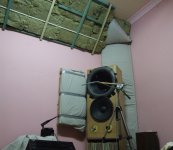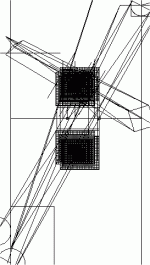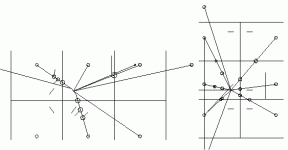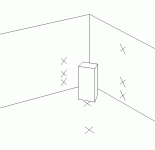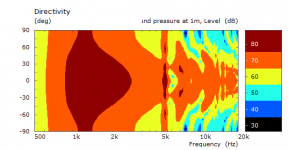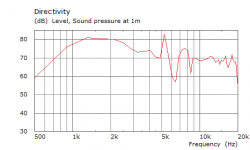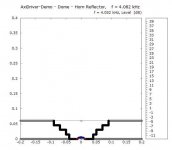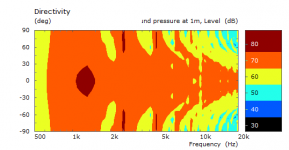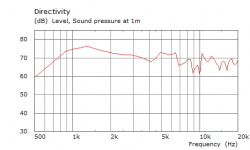The problem with this is it's like peeling an onion. You treat the ceiling, and the ceiling nulls ease and the floor interactions settle with it, but then your rear wall nulls are standing out so you fix those, but they were hiding more floor issues...before you know it you're back to the ceiling wondering whether it would be easier to add more damping or to remove some.
So I guess it will take a few days when I can to shake it up and settle it down. Do you know of any reasonable known baseline target? That is to say, each non-essential first VER should be XdB below the direct...then I could aim for a fixed cut then clean it up in the mix?
This is an old photo, but the front wall is on the left. This now has heavy curtains covering the entire wall, and light ones in front of the speakers. I have mats on the floor, absorbers similar to the front wall ones strung up to the ceiling points on temporary mounts, and I am trapping the contralateral points because they are just too similar in distance as the ceiling.
Which clutters the readings, as does the first horizontal which sometimes seems to boost the low end up over what I'm trying to see.
What I'd like next, before I set up with a ceiling diffractor is to damp heavily beside and behind the speakers. The way I see it is that too many reflections are too similar. The floor, side, rear and combination pairs of these three messing up the lower midrange.
So I guess it will take a few days when I can to shake it up and settle it down. Do you know of any reasonable known baseline target? That is to say, each non-essential first VER should be XdB below the direct...then I could aim for a fixed cut then clean it up in the mix?
This is an old photo, but the front wall is on the left. This now has heavy curtains covering the entire wall, and light ones in front of the speakers. I have mats on the floor, absorbers similar to the front wall ones strung up to the ceiling points on temporary mounts, and I am trapping the contralateral points because they are just too similar in distance as the ceiling.
Which clutters the readings, as does the first horizontal which sometimes seems to boost the low end up over what I'm trying to see.
What I'd like next, before I set up with a ceiling diffractor is to damp heavily beside and behind the speakers. The way I see it is that too many reflections are too similar. The floor, side, rear and combination pairs of these three messing up the lower midrange.
Attachments
Do you know of any reasonable known baseline target?
Not that I am aware of. I believe that a detailed view at reflection patterns is necessary. Common recommendations don't do that.
I traced a good ceiling treatment location and density. I've changed speaker locations a few times so I decided to start from scratch and add some synergy into the absorption scheme this time. I traced out woofer reflection points for primary and secondary reflections and compiled the data based on delay time, the angle the speaker produced it, the order of the mode, and which ear it arrives at.
There was no need for a single absorber solely for the tweeter. Only the floor and ceiling actually needed one but I already had absorbers there. These are mostly for 200-1kHz. What surprises me most is just how compact and ordered they are compared to when I apply treatments as a 'reaction' to observations.
There was no need for a single absorber solely for the tweeter. Only the floor and ceiling actually needed one but I already had absorbers there. These are mostly for 200-1kHz. What surprises me most is just how compact and ordered they are compared to when I apply treatments as a 'reaction' to observations.
Attachments
Allen, did you also look at contralateral reflections? I found 2nd order and even 3rd order contralateral reflections to be pretty high in level, especially when using toe-in.
The first contralateral points are met by close to the zero degree speaker axis. These were some of the longest reflections though and although I'm not confident of this, I decided not to fuss over anything longer than 15ms. I figured by that time it may be more diffuse, and probably doesn't matter as much anyway. Besides, anything that is in its third cancellation by around 150Hz is probably best dealt with by bass treatments instead.
I was luckywith most of the earlier contralaterals. The direct one is diffused by furniture. The near then opposite wall reflection almost coincides with the first near wall absorber which I just have to make a little larger. The opposite wall/floor bounce coincides with the opposite side floor absorber, and the opposite side ceiling reflection absorber might be unsightly so I'm going to ignore it for now
I was luckywith most of the earlier contralaterals. The direct one is diffused by furniture. The near then opposite wall reflection almost coincides with the first near wall absorber which I just have to make a little larger. The opposite wall/floor bounce coincides with the opposite side floor absorber, and the opposite side ceiling reflection absorber might be unsightly so I'm going to ignore it for now
I would also do some ETCs and verify the reflection direction by putting a absorptive panel at the reflection point on the wall. Sometimes one finds reflections from surprising directions.
This also helps evaluating the strength of single reflections. The more one reduces energy of first reflections, the more perceptually effective single reflections become.
This also helps evaluating the strength of single reflections. The more one reduces energy of first reflections, the more perceptually effective single reflections become.
iPhone?! No, I am not an Apple fan. I do have a Windows phone with a camera, and maybe I will do that, but I am just about to fly off to Boston and can't take the time to figure it out. (I have a very good Nikon system and I just can't see using my phone as a camera so I have never actually used it - well a couple of on-the-spot shots - they were terrible. So if I do take a picture it will be with my Nikon.)
Good idea on the ceiling bounce problem by the way. I could certainly do that since my speakers are behind curtains nobody would see it. Ceiling bounce is a big problem to correct.
Lately I've been using my iPhone to catalog my speaker projects on youtube. I mostly do audio to learn things, so I tend to trash projects a week after they're done. Filming them and putting them on Youtube makes it a lot easier to evaluate the projects at a later date, without filling up the garage.
Obviously, a battery of measurements and pictures would be nice too, but that would take hours, and I can film a video with my iPhone and post it to youtube in under 30 minutes.
Sound quality from the iPhone is pretty darn good too. It's noticeably superior to the sound quality of my SLR camera. I'm guessing they put a decent microphone in there since it's primary purpose is to make calls, whereas my SLR's primary purpose is to take pictures.
Now if I could just figure out how to get youtube to stop squashing the audio.
With solid state microphones its pretty easy and cheap to get a good mic. If the quality is bad its usually not because of a poor microphone, but more likely a poor electronics design, A/D, etc.
I am quite a bit confused about the Lipinski radiator. Some say that it is a kindof "waveguide", while others consider them as damped cavities.
Why not an hybrid of both things?
What happen if you build a Lipinsky like cavity with wood instead of foam, that is with a fully reflective material instead of an absorbing one. You get an absolute insane waveguide. Yes, but how bad is it really?
That's what i have tried to simulate with Axidriver, and this is what i get.
The response is clean enough till aprox 5khz and behaves roughly as a conical WG. Above reflections destroy everything.
My guess is that if we use foam instead of wood, absortion will clean the response in the last octaves, while the waveguide behaviour will remain under 5khz because absortion will be less effective at lower freqs...🙄
Why not an hybrid of both things?
What happen if you build a Lipinsky like cavity with wood instead of foam, that is with a fully reflective material instead of an absorbing one. You get an absolute insane waveguide. Yes, but how bad is it really?
That's what i have tried to simulate with Axidriver, and this is what i get.
The response is clean enough till aprox 5khz and behaves roughly as a conical WG. Above reflections destroy everything.
My guess is that if we use foam instead of wood, absortion will clean the response in the last octaves, while the waveguide behaviour will remain under 5khz because absortion will be less effective at lower freqs...🙄
Attachments
Last edited:
- Status
- Not open for further replies.
- Home
- Loudspeakers
- Multi-Way
- Felt or foam walled waveguide?
